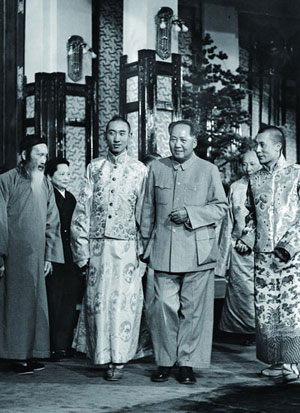Sweeping changes have taken place in Tibet since its peaceful liberation 50 years ago. After the third and fourth forums on the work in Tibet were held in 1994 and 2001, respectively, Tibet, with the help of other parts of China, witnessed leapfrog development, bridged the gap with other relatively developed provinces and cities and embarked on the road of prosperity.
Now, Chairman Mao's instructions on the work in Tibet, which embodied his deep insight and appropriate application, are still of great significance to the work in Tibet at present and even in the future.

On September 11, 1954, Chairman Mao Zedong met with the 14th Dalai Lama and the 10th Panchen Erdeni, photo from Xinhua.
Cautious and steadily-advancing principle
When the People's Liberation Army was sweeping across mainland China in 1949, Chairman Mao began to ponder the Tibetan Plateau under the feudal serfdom. On August 6, 1949, he sent a telegram to General Peng Dehuai, saying, "The Panchen Lama is currently in Lanzhou. When you begin to attack the city, please try to protect and respect him and the Tibetan people living in Gansu and Qinghai provinces, so as to lay a foundation for solving the Tibet issue."
This is Mao's first instruction known to the general public.
At that time, the Tibet local government was under the control of secessionists fostered by imperialist forces, who drove away the staff of the Nationalist Government's representative office in Tibet and actively plotted "Tibet independence".
Some foreign countries including Britain and the United States overtly supported the separatist attempt of the Tibet local government via mass media and by other means. The reactionary and arrogant Tibet local government took this opportunity to expand its Tibetan troops and deploy troops along the Jinsha River in eastern Tibet, in an attempt to resist national reunification by armed forces.
